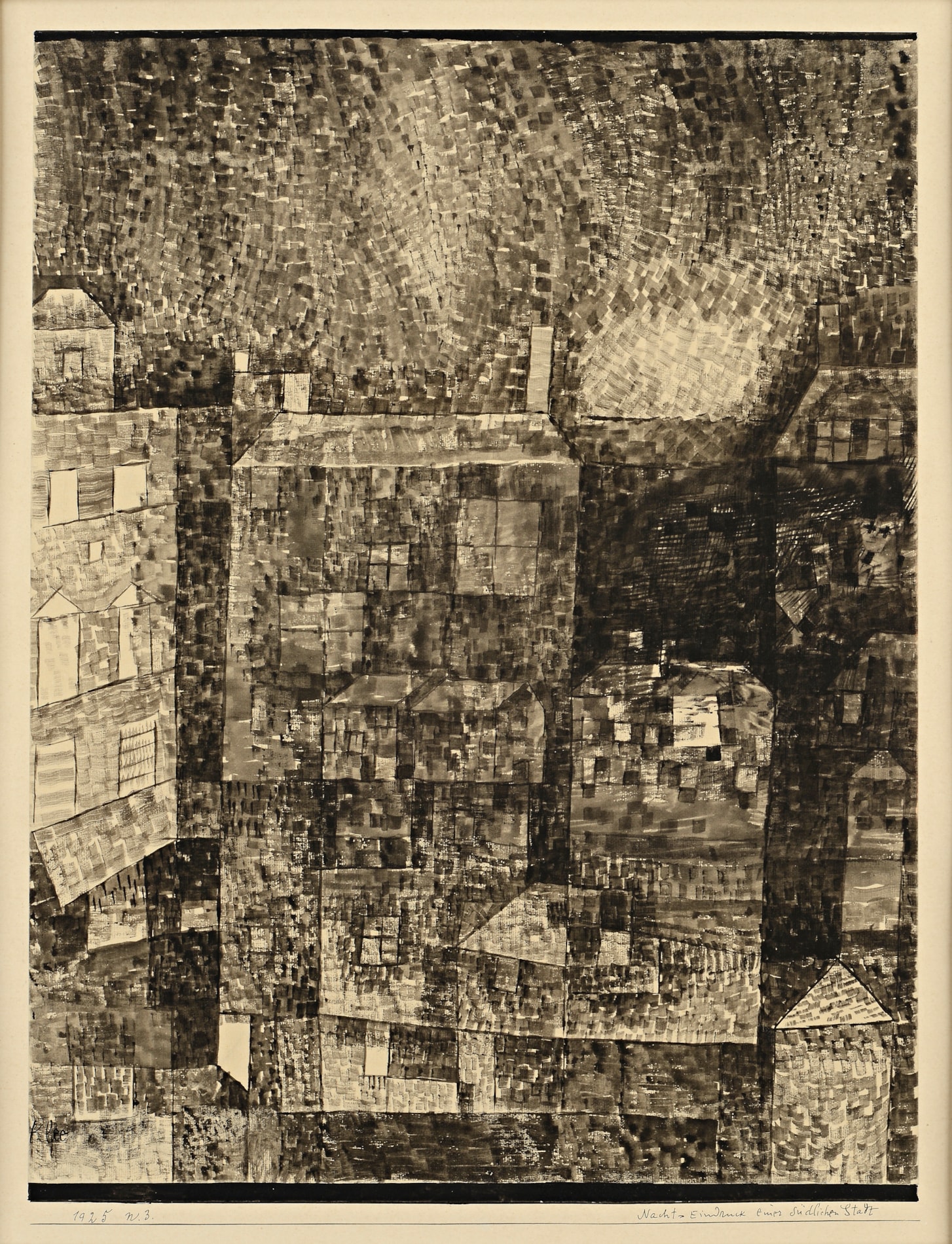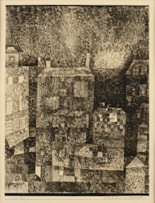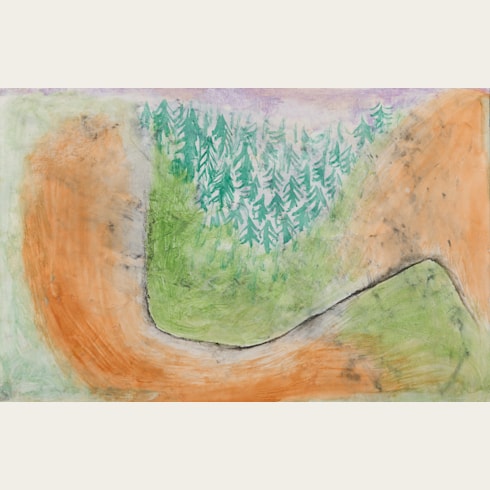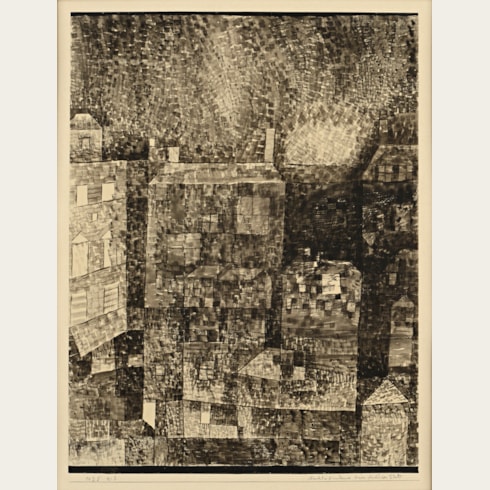Paul KLEE
(Münchenbuchsee 1879 - Muralto 1940)
Nacht-Eindruck einer südlichen Stadt (Night Impression of a Southern Town)
Sold
Pen and black (India) ink and black and grey wash, on paper laid down onto the artist’s mount.
Signed Klee in black ink at the lower left.
Dated and numbered 1925 n.3 and titled Nacht-Eindruck einer südlichen Stadt by the artist in the lower margin.
301 x 226 mm. (11 7/8 x 8 7/8 in.) [image]
411 x 326 mm. (16 1/8 x 12 7/8 in.) [mount]
Signed Klee in black ink at the lower left.
Dated and numbered 1925 n.3 and titled Nacht-Eindruck einer südlichen Stadt by the artist in the lower margin.
301 x 226 mm. (11 7/8 x 8 7/8 in.) [image]
411 x 326 mm. (16 1/8 x 12 7/8 in.) [mount]
This drawing is dated early in 1925, and must reflect Paul Klee’s memories of his trip to Sicily the previous summer. Colour is extraneous in this nocturnal view of a southern town, which depicts the anonymous village in rich detail, with an arrangement of delicately washed grisaille tones applied in small, tesserae-like blocks verging on pointillism. Although drawn in the artist’s Weimar studio rather than on the spot, the use of a mosaic-like technique in this drawing could well reflect Klee’s exposure to the rich mosaics of the churches of Palermo and nearby Monreale.
The same grisaille technique is also seen in only one other major work on paper of 1925; a pen and ink wash drawing entitled 'Kind im Asterngarten' (Child in the Aster Garden), formerly in a Swiss private collection, which appeared at auction in 1990 and 1995.
This drawing was exhibited by Klee’s dealer in Munich, Hans Goltz, shortly after it was drawn in 1925, at Goltz’s gallery in Munich, the Galerie Neue Kunst. The artist had signed a three-year contract with Goltz shortly after leaving military service in 1919, an arrangement which was renewed in 1922.
The same grisaille technique is also seen in only one other major work on paper of 1925; a pen and ink wash drawing entitled 'Kind im Asterngarten' (Child in the Aster Garden), formerly in a Swiss private collection, which appeared at auction in 1990 and 1995.
This drawing was exhibited by Klee’s dealer in Munich, Hans Goltz, shortly after it was drawn in 1925, at Goltz’s gallery in Munich, the Galerie Neue Kunst. The artist had signed a three-year contract with Goltz shortly after leaving military service in 1919, an arrangement which was renewed in 1922.
‘Klee was a gardener in a little piece of paradise. Under his direction his charges blossomed beautifully, full of harmony and grace. His motifs seem to develop with consummate ease, almost – it would seem – of their own accord, and whatever basic note he strikes, his colours contrast in such a way that their sound blends in inevitable harmony. Even when he compresses his pictorial resources to the utmost, he never slips into anything uncontrolled or random. Klee formulates subtly sensitive offerings for the viewer’s eye, offerings so cautious and gentle that they readily elide consumption in this day and age. Paul Klee’s art demands undivided attention – and it is also capable of opening ones eyes to something that lies beyond the image itself.’ (Roland Doschka)
A painter, draughtsman and writer, Paul Klee was born near Bern and studied in Munich under Franz von Stuck. His first independent works date from around 1903, and three years later he settled in Munich, where he met Wassily Kandinsky and became a member of the Neue Künstlervereinigung (New Artist’s Association) and the Blauer Reiter (Blue Rider) group. He had his first one-man exhibitions at Herwarth Walden’s Berlin gallery Der Sturm in March 1916 and February 1917, the success of which established his reputation. Shortly after leaving military service in 1919, Klee signed an exclusive sales contract with the Munich dealer Hans Goltz. In May and June of 1920 Goltz mounted the first substantial exhibition of Klee’s work in his Galerie Neue Kunst in Munich. This was followed in 1923 by another major exhibition of Klee’s work, numbering 270 works, at the Nationalgalerie in Berlin. Appointed to a teaching post at the Bauhaus in Weimar in 1920, Klee continued to work there with the move of the school to Dessau in 1925.
An exhibition of Klee’s work at the newly opened Museum of Modern Art in New York in 1930 cemented the artist’s reputation outside Germany. In 1931 Klee resigned from the Bauhaus to take up a position as professor of painting at the Düsseldorf Akademie, a post he only held for two years before being banned from teaching - as a ‘degenerate artist’ - by the Nazis in 1933. By the end of that year he had moved to Bern in Switzerland. Although Klee produced relatively little work between 1934 and 1936, another large exhibition was mounted at the Kunsthalle in Bern in 1935. The same year he began showing signs of scleroderma, the disease that would eventually kill him five years later. Klee died in June 1940 at the age of sixty-one, three months after the closing of a final major solo exhibition, devoted to his late work of the previous five years, at the Kunsthaus in Zürich.
Provenance
Private collection, Bern, in 1948
Sale, Bern, Kornfeld und Klipstein, 9-10 June 1976, lot 506
Berggruen & Cie, Paris
Fuji Television Gallery Co. Ltd., Tokyo, in 1981
Acquavella Galleries, New York, until 1983
Walter Feilchenfeldt, Zurich
Acquired from them by a private collection, Austria, in 1983
Anonymous sale, London, Christie’s, 24 June 2004, lot 337
Jan Krugier and Marie-Anne Poniatowski, Geneva.
Literature
Du, October 1948, illustrated p.24; Berne, Paul Klee Foundation, Paul Klee. Catalogue Raisonné, Vol.IV 1923-1926, Bern, 2000, p.300, no.3724 (1925,43); Christiane Lange and Roger Diederen, ed., Das ewige Auge – Von Rembrandt bis Picasso: Meisterwerke aus der Sammlung Jan Krugier und Marie-Anne Krugier-Poniatowski, exhibition catalogue, Munich, 2007, pp.342-343, no.163.
Exhibition
Munich, Kunsthalle der Hypo-Kulturstiftung, Das ewige Auge – Von Rembrandt bis Picasso: Meisterwerke aus der Sammlung Jan Krugier und Marie-Anne Krugier-Poniatowski, 2007, no.163.






